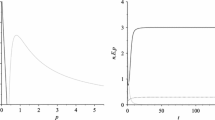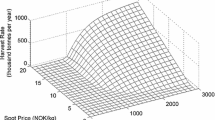Abstract
In this paper we consider a game-theoretic dynamic model describing the exploitation of a renewable resource. Our model is based on a Cournot oligopoly game where n profit-maximizing players harvest fish and sell their catch on m markets. We assume that the players do not know the law governing the reproduction of the resource. Instead they use an adaptive updating scheme to forecast the future fish stock. We analyze the resulting dynamical system which describes how the fish population and the forecasts (expectations) of the players evolve over time. We provide results on the existence and local stability of steady states. We consider the set of initial conditions which give non-negative trajectories converging to an equilibrium and illustrate how this set can be characterized. We show how such sets may change as some structural parameters of our model are varied and how these changes can be explained. This paper extends existing results in the literature by showing that they also hold in our two-dimensional framework. Moreover, by using analytical and numerical methods, we provide some new results on global dynamics which show that such sets of initial conditions can have complicated topological structures, a situation which may be particularly troublesome for policymakers.
Similar content being viewed by others
References
Abraham, R., L. Gardini, and C. Mira. (1997).Chaos in Discrete Dynamical Systems (a Visual Introduction in TwoDimensions). Springer.
Agliari, A., G.I. Bischi, and L. Gardini. (2002).“Some Methods for the Global Analysis of Dynamic Games Represented by Noninvertible Maps.” In T. Puu and I. Sushko (eds.), OligopolyDynamics: Tools & Models, Springer, pp. 31–83.
Bischi, G.I., M. Kopel, and A. Naimzada (2001) “On a Rent-seeking Game Described by a Noninvertible Iterated MapWith Denominator.” Nonlinear Analysis 47, 5309–5324.
Bischi, G.I. and M. Kopel (2001) “Equilibrium Selection in a Nonlinear Duopoly Game with Adaptive Expectations.” Journal of Economic Behavior and Organization 46, 73–100.
Bischi, G.I., and M. Kopel. (2002). “The Role of Competition, Expectations and Harvesting Costs in Commercial Fishing.” In T. Puu and I. Sushko (eds.), Oligopoly Dynamics: Tools & Models. Springer, pp. 85–109.
Bischi, G.I. and M. Kopel (2003) “Long Run Evolution, Path Dependence and Global Properties of Dynamic Games: A Tutorial.” Cubo A Mathematical Journal 5(3), 437–468.
Bischi, G.I. and R. Marimon. (2001). “Global Stability of Inflation Target Policies With Adaptive Agents.” Macroeconomic Dynamics 5, 148–179.
Bischi, G.I., L. Gardini, and M. Kopel (2000) “Analysis of Global Bifurcations in a Market Share Attraction Model.” Journal of Economic Dynamics and Control 24, 855–879.
Bischi, G.I., H. Dawid, and M. Kopel. (2003a). “Spillover Effects and the Evolution of Firm Clusters.” Journal of Economic Behavior and Organization 50, 47–75.
Bischi, G.I., H. Dawid, and M. Kopel. (2003b). “Gaining the Competitive Edge Using Internal and ExternalSpillovers: A Dynamic Analysis.” Journal of Economic Dynamics and Control 27, 2171– 2193.
Brock, W. and C. Hommes. (1997). “A Rational Route to Randomness.” Econometrica 65, 1059–1095.
Clark, C.W. (1990). Mathematical Bioeconomics—The Optimal Management of Renewable Resources. Wiley.
Clark, C.W. and G.P. Kirkwood (1986) “On Uncertain Renewable Resource Stocks: Optimal Harvest Policies and the Value of Stock Surveys.” Journal of Environmental Economics and Management 13, 235–244.
Conrad, J.M (1995) “Bioeconomic Models of the Fishery.” In D.W. Bromley (ed.), Handbook of Environmental Economics. Cambridge, MA: Basil Blackwell, pp. 405–432.
Deissenberg, C., G. Feichtinger, W. Semmler, and F. Wirl (2003) “Multiple Equilibria, History Dependence, and Global Dynamics in Interteporal Optimizations Models.” Forthcoming In W. Barnett, Ch. Deissenberg, and G. Feichtinger (eds.), Economic Complexity: Non-linear Dynamics, Multi-agent Economies, and Learning. ISETE Vol. 14, Amsterdam Elsevier.
Dutta, P.K. and R.K. Sundaram (1993) “The Tragedy of the Commons?” Economic Theory 3, 413–426.
Grebogi, C., S.W. McDonald, E. Ott, and J.A. Yorke (1983) “Final State Sensitivity: An Obstruction to Predictability.” Physics Letters 99A(9), 415–418.
Gumowski, I. and C. Mira (1980) Dynamique Chaotique. Cepadues Editions, Toulose.
Hannesson, R (1995) “Sequential Fishing: Cooperative and Non-Cooperative Equilibria.” Natural Resource Modeling 9, 51–59.
Levhari, D. and L.J. Mirman (1982) “The Great Fish War: An Example Using a Dynamic Cournot-Nash Solution.” In L.J. Mirman and D.F. Spulber (eds.), Essays in the Economics of Renewable Resources. North-Holland, pp. 243–258.
Máler, K.G (2000) “Development, Ecological Resources and their Management: A Study of Complex Dynamic Systems.” European Economic Review 44, 645–665.
May, R.M. (1987) “Chaos and the Dynamics of Biological Populations.” Proc. R. Soc. (London), A 413, 27–44.
May, R.M. (1976) “Simple Mathematical Models With Very Complicated Dynamics.” Nature 261, 459– 467.
May, R.M. and G.F. Oster (1976) “Bifurcations and Dynamic Complexity in Simple Ecological Models.” The American Naturalist 110, 573–599.
McDonald, S.W., C. Grebogi, E. Ott, and J.A. Yorke (1985) “Fractal Basin Boundaries.” Physica 17D, 125–153.
McKelvey, R. (1997). “Game-Theoretic Insights Into the International Management of Fisheries.” Natural Resource Modeling 10, 129–171.
Medio, A. and M. Lines (2001) Nonlinear Dynamics. Cambridge (UK): Cambridge University Press.
Mesterton-Gibbons, M (1993) “Game-Theoretic Resource Modeling.” Natural Resource Modeling 7, 93–147.
Mira, C., L. Gardini, A. Barugola, and J.C. Cathala (1996) Chaotic Dynamics in Two-Dimensional Noninvertible Maps. World Scientific.
Munro, G.R. and A.D. Scott (1985) “The Economics of Fisheries Management.” In A.V. Kneese and J.L. Sweeney (eds.), Handbook of Natural Resource and Energy Economics. Elsevier Science Publishers, pp. 623–676.
Nerlove, M (1958) “Adaptive Expectations and Cobweb Phenomena,” Quarterly Journal of Economics 72, 227–240.
Puu, T (2000) Attractors, Bifurcations and Chaos. Nonlinear Phenomena in Economics. Springer.
Rosser, J.B. Jr (2001) “Complex Ecologic-Economic Dynamics and Environmental Policy.” Ecological Economics 37, 23–37.
Rosser, J.B. Jr (2002) “Implications for Fisheries Policy of Complex Ecologic Economic Dynamics.” Nonlinear Dynamics, Psychology, and Life Sciences 6, 103–120.
Sethi, R. and E. Somanathan (1996) “The Evolution of Social Norms in Common Property Resource Use.” American Economic Review 86, 766–788.
Szidarovszky, F. and K. Okuguchi (1998) “An Oligopoly Model of Commercial Fishing.” Seoul Journal of Economics 11, 321–330.
Szidarovszky, F. and K. Okuguchi (2000) “A Dynamic Model of International Fishing.” Seoul Journal of Economics 13, 471–476.
Szidarovszky, F., K. Okuguchi, and M. Kopel (2003) “International Fishery With Several Countries.” Working Paper.
Author information
Authors and Affiliations
Corresponding author
Rights and permissions
About this article
Cite this article
Bischi, GI., Kopel, M. & Szidarovszky, F. Expectation-Stock Dynamics in Multi-Agent Fisheries. Ann Oper Res 137, 299–329 (2005). https://doi.org/10.1007/s10479-005-2262-7
Issue Date:
DOI: https://doi.org/10.1007/s10479-005-2262-7




